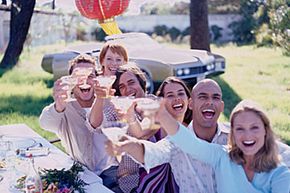Wine tourism has grown exponentially in the United States since the 1970s. Before then, Americans didn't drink too much wine, and the country was certainly not known for producing quality wine compared to other countries like France, Italy and Spain. But the reputation of the United States (and California in particular) has risen over the past few decades as a contender in the international scene of wine producers. And the prospect of scenic agrarian landscapes, charming wineries and exquisite wine tasting has prompted more and more tourists to hit the road to explore the country's wine regions.
Making wine is a multifaceted process, involving growing, harvesting and crushing grapes, fermentation, filtering and blending, and bottling and storing. Many wineries often have their own vineyards where they grow and harvest grapes, but some simply choose to buy grapes from other growers. Besides the allure of going straight to the source to try particular wines, another attraction that brings tourists flocking to wineries is the chance to tour the facilities and learn about a particular wine-making process.
Advertisement
Of course, because multiple wineries are often clustered around the best wine-making regions, and few tourists are satisfied with one visit after a long drive, it makes sense to make a day of it -- or even multiple days. But the best wine road trips involve some planning.
The first and most important step, of course, is to pick a wine-making region appropriate for your trip. And you might be surprised to find that a good wine country is nearer to you than you think. Although California, replete with well-known wine regions like Napa Valley, Sonoma Valley, Santa Barbara, Paso Robles and Mendocino, has the most popular wine tourism destinations, some regions in other states are worth considering, too. Some examples are the Walla Walla and Columbia valleys in Washington state, or the Willamette and Columbia valleys of Oregon. New York even has very respected wineries centered in the Hudson River Valley and Finger Lakes area. Wine producing regions of Virginia, Colorado and Texas are also worth visiting.
So, if you live far from California, and you're interested in trying what other regions have to offer, look for a wine country near you. And if you have a favorite wine, like merlot or zinfandel, look for regions that specialize in that.
Advertisement
